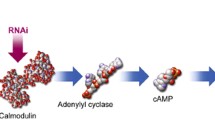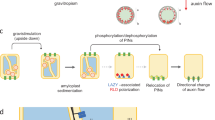Abstract
In single-celled spores of the fern Ceratopteris richardii, gravity directs polarity of development and induces a directional, trans-cellular calcium (Ca2+) current. To clarify how gravity polarizes this electrophysiological process, we measured the kinetics of the cellular response to changes in the gravity vector, which we initially estimated using the self-referencing calcium microsensor. In order to generate more precise and detailed data, we developed a silicon microfabricated sensor array which facilitated a lab-on-a-chip approach to simultaneously measure calcium currents from multiple cells in real time. These experiments revealed that the direction of the gravity-dependent polar calcium current is reversed in less than 25 s when the cells are inverted, and that changes in the magnitude of the calcium current parallel rapidly changing g-forces during parabolic flight on the NASA C-9 aircraft. The data also revealed a hysteresis in the response of cells in the transition from 2g to micro-g in comparison to cells in the micro-g to 2-g transition, a result consistent with a role for mechanosensitive ion channels in the gravity response. The calcium current is suppressed by either nifedipine (calcium-channel blocker) or eosin yellow (plasma membrane calcium pump inhibitor). Nifedipine disrupts gravity-directed cell polarity, but not spore germination. These results indicate that gravity perception in single plant cells may be mediated by mechanosensitive calcium channels, an idea consistent with some previously proposed models of plant gravity perception.






Similar content being viewed by others
References
Adkins EM, Samuvel DJ, Fog JU, Eriksen J, Jayanthi LD, Vaegter CB, Ramamoorthy S, Gether U (2007) Membrane mobility and microdomain association of the dopamine transporter studied with fluorescence correlation spectroscopy and fluorescence recovery after photobleaching. Biochemistry 46:10484–10497
Braam J (2005) In touch: plant responses to mechanical stimuli. New Phytol 165:373–389
Bushart TJ, Roux SJ (2007) Conserved features of germination and polarized cell growth: a few insights from a pollen-fern spore comparison. Ann Bot 99:9–17
Carlsson AE, Shah AD, Elking D, Karpova TS, Cooper JA (2002) Quantitative analysis of actin patch movement in yeast. Biophys J 82:2333–2343
Chatterjee A, Porterfield DM, Smith PS, Roux SJ (2000) Gravity-directed calcium current in germinating spores of Ceratopteris richardii. Planta 210:607–610
Chen Y, Simasko SM, Niggel J, Sigurdson WJ, Sachs F (1996) Ca2+ uptake in GH3 cells during hypotonic swelling: the sensory role of stretch-activated ion channels. Am J Physiol 270:C1790–C1798
De Michelis MI, Carnelli A, Rasi-Caldogno F (1993) The Ca2+ pump of the plasma-membrane of Arabidopsis thaliana—characteristics and sensitivity to fluorescein derivatives. Bot Acta 106:20–25
Demidchik V, Tester M (2002) Sodium fluxes through nonselective cation channels in the plasma membrane of protoplasts from Arabidopsis roots. Plant Physiol 128:379–387
Ding JP, Pickard BG (1993) Mechanosensory calcium-selective cation channels in epidermal cells. Plant J 3:83–110
Dutta R, Robinson KR (2004) Identification and characterization of stretch-activated ion channels in pollen protoplasts. Plant Physiol 135:1398–1406
Edwards ES, Roux SJ (1994) Limited period of graviresponsiveness in germinating spores of Ceratopteris richardii. Planta 195:150–152
Edwards ES, Roux SJ (1998) Influence of gravity and light on the developmental polarity of Ceratopteris richardii fern spores. Planta 205:553–560
Haswell ES, Meyerowitz EM (2006) MscS-like proteins control plastid size and shape in Arabidopsis thaliana. Curr Biol 16:1–11
Hepler PK (2005) Calcium: a central regulator of plant growth and development. Plant Cell 17:2142–2155
Hetherington AM, Brownlee C (2004) The generation of Ca2+ signals in plants. Ann Rev Plant Biol 55:401–427
Holdaway Clarke TL, Feijo JA, Hackett GR, Kunkel JG, Hepler PK (1997) Pollen tube growth and the intracellular cytosolic calcium gradient oscillate in phase while extracellular calcium influx is delayed. Plant Cell 9:1999–2010
Ingber D (1999) How cells (might) sense microgravity. FASEB J 13:S3–S15
Kordyum EL (2003) Calcium signaling in plant cells in altered gravity. Adv Space Res 32:1621–1630
Kucik DF, Elson EL, Sheetz MP (1989) Forward transport of glycoproteins on leading lamellipodia in locomoting cells. Nature 340:315–317
Leonetti M, Dubois-Violette E, Homble F (2004) Pattern formation of stationary transcellular ionic currents in Fucus. Proc Natl Acad Sci 101:10243–10248
Lin W, Laitko U, Juranka PF, Morris CE (2007) Dual stretch responses of mHCN2 pacemaker channels: accelerated activation, accelerated deactivation. Biophys J 92:1559–1572
Luoni L, Bonza MC, Michelis MID (2000) H+/Ca2+ exchange driven by the plasma membrane Ca2+-ATPase of Arabidopsis thaliana reconstituted in proteoliposomes after calmodulin-affinity purification. FEBS Lett 482:225–230
McBride DW, Hamill OP (1993) Pressure-clamp technique for measurement of the relaxation kinetics of mechanosensitive channels. Trends Neurosci 16:341–345
Messerli MA, Robinson KR (2007) MS channels in tip-growing systems. Curr Top Membr 58:393–412
Nakagawa Y, Katagiri T, Shinozaki K, Qi Z, Tatsumi H, Furuichi T, Kishigami A, Sokabe M, Kojima I, Sato S, Kato T, Tabata S, Iida K, Terashima A, Nakano M, Ikeda M, Yamanaka T, Iida H (2007) Arabidopsis plasma membrane protein crucial for Ca2+ influx and touch sensing in roots. Proc Natl Acad Sci 104:3639–3644
Nakayama Y, Fujiu K, Sokabe M, Yoshimura K (2007) Molecular and electrophysiological characterization of a mechanosensitive channel expressed in the chloroplasts of Chlamydomonas. Proc Natl Acad Sci 104:5883–5888
Pelham RJ, Chang F (2001) Role of actin polymerization and actin cables in actin-patch movement in Schizosaccharomyces pombe. Nat Cell Biol 3:235–244
Pickard BG, Fujiki M (2005) Ca2+ pulsation in BY-2 cells and evidence for control of mechanosensory Ca2+-selective channels by the plasmalemmal reticulum. Funct Plant Biol 32:863–879
Rasi-Caldogno F, Pugliarello MC, De Michelis MI (1987) The Ca2+-transport ATPase of plant plasma membrane catalyzes a nH+/Ca2+ exchange. Plant Physiol 83:994–1000
Robinson KR, Jaffe LF (1975) Polarizing fucoid eggs drive a calcium current through themselves. Science 187:70–72
Rokkam M, Chatni MR, Haque Au, De Carlo AR, Robinson BF, Irazoqui PP, Porterfield DM (2007) High-density data acquisition system and signal preprocessor for interfacing with microelectromechanical system-based biosensor arrays. Rev Sci Instrum 78:044303–044309
Roux SJ, Chatterjee A, Hillier S, Cannon T (2003) Early development of fern gametophytes in microgravity. Adv Space Res 31:215–220
Ryder KD, Duncan RL (2001) Parathyroid hormone enhances fluid shear-induced [Ca2+](i) signaling in osteoblastic cells through activation of mechanosensitive and voltage- sensitive Ca2+ channels. J Bone Miner Res 16:240–248
Sachs F (2002) Retaining your identity under stress. Nat Struct Mol Biol 9:636–637
Sanders D, Brownlee C, Harper JF (1999) Communicating with Calcium. Plant Cell 11:691–706
Syntichaki P, Tavernarakis N (2004) Genetic models of mechanotransduction: the nematode Caenorhabditis elegans. Physiol Rev 84:1097–1153
ul Haque A, Rokkam M, De Carlo AR, Wereley ST, Roux SJ, Irazoqui PP, Porterfield DM (2007) A MEMS fabricated cell electrophysiology biochip for in silico calcium measurements. Sens Actuators B: Chem 123:391–399
Vallée N, Brière C, Petitprez M, Barthou H, Souvré A, Alibert G (1997) Studies on ion channel antagonist-binding sites in sunflower protoplasts. FEBS Lett 411:115–118
Waddle JA, Karpova TS, Waterston RH, Cooper JA (1996) Movement of cortical actin patches in yeast. J Cell Biol 132:861–870
Yang C, Wei D, Zhuang FY (2008) The force induced by organelles’ weight in the microfilament is in the range of 0.1–1 pN. Acta Astronaut 63:923–928
Zhao M, Song B, Pu J, Wada T, Reid B, Tai G, Wang F, Guo A, Walczysko P, Gu Y, Sasaki T, Suzuki A, Forrester JV, Bourne HR, Devreotes PN, McCaig CD, Penninger JM (2006) Electrical signals control wound healing through phosphatidylinositol-3-OH kinase-[gamma] and PTEN. Nature 442:457–460
Acknowledgments
We thank Guy Thompson and Greg Clark for discussion and suggestions, Alan Shipley at Applicable Electronics for assistance with ion-selective electrode system setup, Harvey Fishman at U. Texas Medical Branch at Galveston for equipment used in microelectrode experiments and Bill McLamb for help in the parabolic flight experiments. This work was supported by NASA grants to S.J.R. (NAG10-295), S.C.S. (NGT5-50371), and D.M.P.
Author information
Authors and Affiliations
Corresponding author
Electronic supplementary material
Below is the link to the electronic supplementary material.
Rights and permissions
About this article
Cite this article
Salmi, M.L., ul Haque, A., Bushart, T.J. et al. Changes in gravity rapidly alter the magnitude and direction of a cellular calcium current. Planta 233, 911–920 (2011). https://doi.org/10.1007/s00425-010-1343-2
Received:
Accepted:
Published:
Issue Date:
DOI: https://doi.org/10.1007/s00425-010-1343-2




